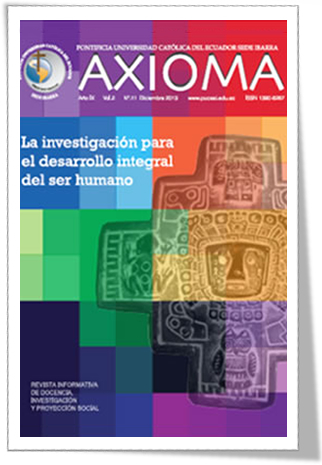Agricultural management of Amaranth and Quinua with Metarhizium anisopliae for the control of insects
Main Article Content
Abstract
The experiment was conducted at the Pontificia Universidad Católica del Ecuador - Sede Ibarra (PUCE-SI), in the experimental farm, three doses of entomopathogenic Metarhizium anisopliae was evaluated for the control of worms that affect the initial development of crop quinoa (Chenopodium quinoa Willd) and amaranth (Amaranthus spp.) Design of randomized complete block design with three treatments and four replications for each crop was used. Within the specific management of the experiment, each experimental unit consisted of a plot of 5 m long, 2 meters wide , in which 4 spaced at 0 furrows were laid , 5 m, of which the central rows were evaluated and the remaining two were taken as the edge effect.The variables in this research were evaluated. The efficacy in the control of soil insects, indirectly measured using Abbot’s formula for the number of affected seedlings after application and at 10, 20 and 30 days after borning. They were evaluated as variables: a) Effectiveness application to 15,25 and 35 days after borning and b ) performance achieved at harvest. It was concluded that there is no difference in crop yield when the entomopathogenic fungus Metarhizium anisopliae for the control of soil insects used.The highest yield was achieved with the use of 340 g x ha- 1 entomotatógeno with a volume of grain 1520 kg x ha-1. For amaranth grain harvested was 1506.25 kg x ha-1, with the same dose of the fungus.
Downloads
Article Details
Con la finalidad de contar con un tipo de licencia más abierta en el espectro que ofrece Creative Commons, a partir de diciembre de 2022 desde el número 27, AXIOMA asume la Licencia Creative Commons 4.0 de Reconocimiento-NoComercial-CompartirIgual 4.0(CC BY-NC-SA 4.0). Tanto el sitio web como los artículos en sus diferentes formatos, reflejan esta información.
![]()
Hasta el mes de noviembre de 2022 con el número 26, la revista AXIOMA asumió una Licencia Creative Commons Atribución-NoComercial-SinDerivadas 4.0 Internacional (CC BY-NC-ND 4.0). Los artículos contenidos en cada número hasta el 26, cuentan con esta licencia y su descripción se conserva en el portal de nuestra revista.
Atribución-NoComercial-SinDerivadas
CC BY-NC-ND
AXIOMA- Revista Científica de Investigación, Docencia y Proyección Social
References
Ayala, P. (2010). Evaluación del desempeño de Mi-croorganismos Eficaces (EMAS, PGPRs) para mejorar la productividad y Entomopatógenos (Metarhizium ani-soplae, Beauveria bassiana, Nomurea riely) en el con-trol de plagas del cultivo de Quinua (Chenopodium qui-noa) en la granja experimental ECAA. Tesis de grado. PUCE-SI. Ibarra, Ecuador.
Lawrence, L. (2012). Manual of Techniques in Inver-tebrate Pathology. Segunda Edición. Academic Press.San Diego, California USA.
Mujica, A. et al (2001). Quinua. Ancestral cultivo andino. Alimento del Presente y Futuro. FAO. Santiago de Chile
----------------- (1997). El Cultivo del Amaranto. FAO. Santiago de Chile
Ortiz, R. et al (2001). Plagas y enfermedades. Quinua. Ancestral cultivo andino, alimento del presente y futu-ro. FAO, Santiago de Chile
imbaña, A. & Andrade, V. (2011) Evaluación del des-empeño de microorganismos entomopatógenos en el cultivo de quinua. PUCE-SI. Ibarra, Ecuador

